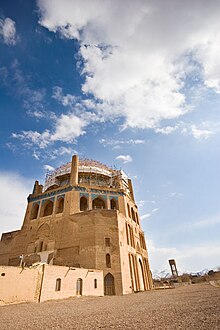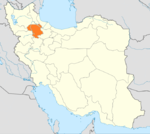Soltaniyeh
| UNESCO World Heritage Site | |
|---|---|
 | |
| Criteria | Cultural: ii, iii, iv |
| Reference | 1188 |
| Inscription | 2005 (29th Session) |

Soltaniyeh (Template:Lang-fa) situated in the Zanjan Province of Iran, some 240 km to the north-west from Tehran, used to be the capital of Ilkhanid rulers of Persia in the 14th century. Its name translates as "the Imperial". In 2005, UNESCO listed Soltaniyeh as one of the World Heritage Sites.
The central magnet of Soltaniyeh's several ruins is the Mausoleum of Il-khan Öljeitü also known as Muhammad Khodabandeh(Persian اولجايتو), traditionally known as the Dome of Soltaniyeh.
The structure, erected from 1302 to 1312 AD, has the oldest double-shell dome in the world.[citation needed] Its importance in the Muslim world may be compared to that of Brunelleschi's cupola for Christian architecture. It is the largest brick dome in the world[1], just at the theoretical engineering limit for a brick dome and the third largest Dome in the world after domes of Florence Cathedral and Hagia Sophia. The Dome of Soltaniyeh paved the way for more daring Iranian-style cupola constructions in Muslim world, such as the Mausoleum of Khoja Ahmed Yasavi and Taj Mahal. Much of exterior decoration has been lost, but the interior retains superb mosaics, faience, and murals. People have described the architecture of the building as “anticipating the Taj Mahal.”
The estimated[weasel words] 200 ton dome stands 49 meters (161 ft) tall from its base, and is currently[when?] undergoing extensive renovation.
See also
External links
- Official website
- World Heritage profile
- Video of Soltaniyeh
- Farnoush Tehrāni, The Crown of All Domes, in Persian, Jadid Online, 31 December 2009, [1].
• Audio slideshow: [2] (6 min 45 sec).
References
36°26′N 48°47′E / 36.433°N 48.783°E
This article needs additional citations for verification. (January 2010) |



